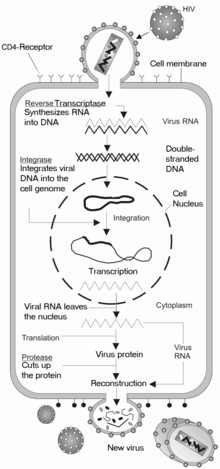| This article needs additional citations for verification. Please help improve this article by adding citations to reliable sources. Unsourced material may be challenged and removed. Find sources: "Tissue tropism" – news · newspapers · books · scholar · JSTOR (May 2022) (Learn how and when to remove this message) |
Tissue tropism is the range of cells and tissues of a host that support growth of a particular pathogen, such as a virus, bacterium or parasite.
Some bacteria and viruses have a broad tissue tropism and can infect many types of cells and tissues. Other viruses may infect primarily a single tissue. For example, rabies virus affects primarily neuronal tissue. Similarly, JC virus (JCV) primarily affects and resides in kidneys.
Influencing factors
Factors influencing viral tissue tropism include:
- The presence of cellular receptors permitting viral entry.
- Availability of transcription factors involved in viral replication.
- The molecular nature of the viral tropogen or virus surface, such as the glycoprotein, which interacts with the corresponding cell receptor.
The cellular receptors are the proteins found on a cell or viral surface. These receptors are like keys, allowing the viral cell to fuse with or attach itself to a cell. The way that these proteins are acquired is through a similar process to that of an infection cycle.
How 'tropic' tissue is acquired

Tissue tropism develops in the following stages:
- Virus with GPX enters body (where GP - glycoprotein and X is the numeric value given to the GP)
- Viral cell "targets" cell with a GPX receptors
- Viral cell fuses with the host cell and inserts its contents into the host cell
- Reverse transcription occurs
- Viral DNA is incorporated with host DNA via viral enzyme
- Production of RNA and viral protein
- Viral particle is assembled
- Viral particle buds out of the cell, taking a chunk of the cell membrane with it and acquiring a new tissue with all the receptors it needs to continue tissue tropism
Example: HIV has a gp120, which is precisely what the CD4 marker is on the surface of the macrophages and T cells. Thus HIV can enter T cells and macrophages
See also
References
- ^ McCall, LI; Siqueira-Neto, JL; McKerrow, JH (May 2016). "Location, Location, Location: Five Facts about Tissue Tropism and Pathogenesis". PLOS Pathogens. 12 (5): e1005519. doi:10.1371/journal.ppat.1005519. PMC 4881934. PMID 27227827.
- Silva Pereira, Sara; Trindade, Sandra; De Niz, Mariana; Figueiredo, Luisa M. (31 May 2019). "Tissue tropism in parasitic diseases". Open Biology. 9 (5): 190036. doi:10.1098/rsob.190036. ISSN 2046-2441. PMC 6544988. PMID 31088251.
- Cayres-Vallinoto IM, Vallinoto AC, Azevedo VN, Machado LF, Ishak Mde O, Ishak R (2012). "Human JCV infections as a bio-anthropological marker of the formation of Brazilian Amazonian populations". PLoS One. 7 (10): e46523 – e46523. doi:10.1371/journal.pone.0046523. PMC 3470572. PMID 23071582.